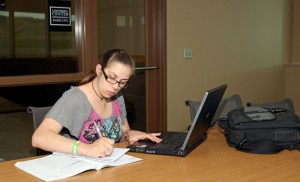As the dean of continuing and extended education, Gail Tidemann’s office has administrative oversight of SDSU’s online classes. Tidemann, who retired in May after more than 25 years at SDSU, has watched off-campus and distance education at State grow and change over the years as technology has enabled universities like SDSU to reach students in a variety of ways.
“Before we had many options for distance education, I used to teach when you got in your car and drove a distance,†Tidemann says. “That was the way we provided off-campus instruction.â€
Those days are largely gone, though an occasional course might be taught at an out-of-the-way location. Today offering courses to students at a distance typically takes two forms: online courses and classes taught at SDSU-affiliated attendance centers that include University Center-Sioux Falls, University Center-Rapid City and Capital University Center in Pierre.
Making higher education available to citizens is a key mission of land-grant universities, and, according to Tidemann, it’s one that SDSU has been fulfilling for many years.
At first, professors got on the road like Tidemann did. As she prepared for retirement, Tidemann ran across batches of old registration forms including a set from 1988 for classes held in Rapid City.
“We have tons of these records where folks took courses at many different locations,†Tidemann says, noting that classes were typically held in a community room or in an unused classroom on another campus.
Distance education offerings began to grow with the Rural Development Television Network followed by the Dakota Digital Network. It allowed an instructor at a campus studio location to broadcast a lecture to classrooms that were wired into the network.
The latest innovations—online courses and attendance centers—have made great leaps forward in convenience and the ability to connect with students on a personal level.
Attendance centers got their start in 2001 when SDSU started offering courses on the campus of Southeast Technical Institute. The University Center-Sioux Falls opened its locations in 2009 and 2011 and the University Center-Rapid City opened in 2011. After years of offering courses in the basement of St. Mary’s Hospital, the Capital University Center opened its attendance center in 2009.
The first few online courses were offered at State in 1998. In 2012, SDSU offered 34,000 credit hours of classes online, about 10 to 11 percent of State’s credits for the year.
In the 2011-2012 academic year, 5,800 students took one or more online classes. While that number includes traditional students who may fill out their schedule with an online class, Tidemann believes that the classes taught through the Internet are the most beneficial for students away from campus who are tied to another community through work or family obligations.
Dana Hess






